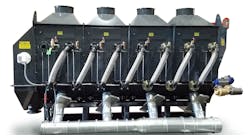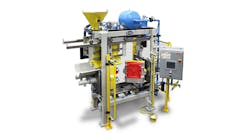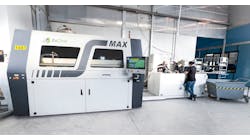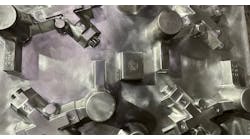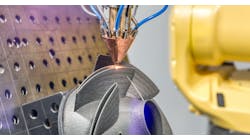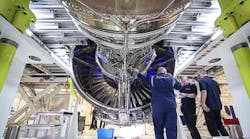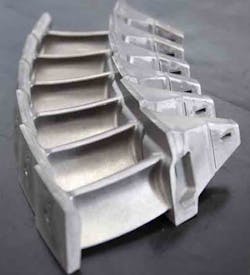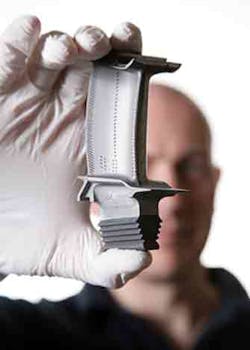Rolls-Royce plc has opened a new investment-casting foundry to produce over 100,000 single-crystal turbine blades per year, in support of its Trent aircraft engine product line. The estimated $170-million project in Rotherham, England, was started in 2012, and will be fully operational by 2017.
The Advanced Blade Casting Facility’s (ABCF) uses some manufacturing methods developed by Rolls-Royce at the Manufacturing Technology Centre, an industrial research center at Ansty, backed by three universities and numerous manufacturing firms.
The 150,000-sq.ft. ABCF will employ 150, Rolls-Royce announced.
The engine builder has not detailed all of the production processes available at ABCF, but noted it has automated integrated wax fabrication lines; 3D structured light inspection, which measures the entire surface of components; and computed tomography (CT), which measures finished blades’ internal structures. Rolls said these techniques reduce the time it takes to manufacture a turbine blade by 50%.
“Rolls-Royce is committed to investing in innovative technology and world-class facilities to help us deliver our record £73.7 billion order book,” commented Gareth Davies, Rolls-Royce executive vice president, Turbines. “This facility will use ground-breaking manufacturing techniques to produce single crystal turbine blades for our Trent engines, including the world's most efficient aero civil engine, the Trent XWB.”
Rolls-Royce is the world’s second-largest manufacturer of jet engines for commercial aircraft builders, including Airbus, which installs the Rolls-Royce Trent XWB high-bypass turbofan engine in its new A350 XWB aircraft.
Investment casting is critical to achieving the structural integrity necessary for the engines’ turbine blades. The turbine draws energy from a hot gas stream delivered by the engine’s combustor, and uses that energy to power the fan and the compressors. The blades to be produced at the ABCF will perform at temperatures up to 200°C above the melting point of their alloy, Rolls-Royce detailed, rotating at more than 12,000 rpm. In that process, each blade is subjected to more than 12 tons of centrifugal force.
Investment-cast turbine blades are formed by filling a permanent mold with wax, then using the wax models to form ceramic molds. When the molds are set the wax is evaporated, and the cavities are filled with nickel-based superalloy.
The critical aspect of investment casting for turbine blades is the directional solidification process, in this case single-crystal solidification. The molds filled with the molten super alloy are placed in a vacuum induction melting furnace so that each blade can form around a single crystal.
Rolls noted that two types of single-crystal turbine blades are manufactured at Rotherham: high pressure (HP) and intermediate pressure (IP).
Each Trent XWB engine includes 182 turbine blades. Each blade is approximately 10 cm high and weighs 300 g. There are about 200 steps of production for each blade before it is ready to be installed in an engine.




